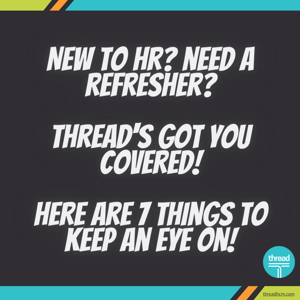Few things are more frustrating for employers than finding out that a new hire oversold their knowledge, skills, and abilities. The employee looked great on paper and appeared confident and competent in the interview, but when it came to doing the basic duties of the job, they didn’t have what it took.
To lessen the likelihood of this unfortunate situation, some employers want to see the candidate in action before formally hiring them. They’ll invite the candidate to spend a day or so at the workplace, shadowing a seasoned employee or doing some of the position's tasks. This is known as a working interview. It’s legal to conduct working interviews, but there are serious drawbacks and risks to understand and consider. Consequently, we generally don’t recommend doing them. However, if you do conduct them, here are some issues to be aware of:
Compensation
First, working interviews must be compensated at a rate of at least the minimum wage. You’re basically hiring the candidate as an employee for that span of time. You would need to have the person complete a Form W-4 and Form I-9 to do the work at the bare minimum. You cannot classify someone as an independent contractor as they don’t meet the legal criteria for that classification. Legally, they are temporary employees – even though their time is fixed at one day or a couple of hours. Should you decide to go this route, we recommend having a check prepared for them to take with them at the end of the day. This way, you don’t run afoul of any state laws on the delivery of final paychecks.
Risks
There are several risks to consider if you decide to do a working interview. The candidate could be injured during that time, and you would be liable for a workers' compensation claim. If the employee wasn’t reported and paid correctly, your workers’ compensation carrier might not cover the claim. Additionally, candidates completing working interviews could file for unemployment if you do not hire them for additional work after the working interview. Unemployment tax is tied to the prospect’s wages during the preceding year, not to the employer. That said, the shorter the period the person is employed by you, the less they will draw from your unemployment account.
Luckily, there are several alternatives to the working interview.
Alternative 1: Use a Temp Agency
If it's essential to observe the candidate in your office under regular working conditions, you can contact a temporary agency and inquire if they would hire the candidate for a single day. The person would then be the employee of the temp agency, and an employee-employer relationship wouldn't be created between your company and the candidate. If you anticipate a lot of working interviews, this might be a good option to explore. You will, however, pay a premium for this service.
Alternative 2: Skills Testing
Another option is making a skills test part of the interview. The difference between working interviews and skills testing is the environment in which they are done. During a working interview, you ask the candidate to work alongside an employee or complete tasks that benefit your organization. For instance, if you were to ask a candidate for an accounting position to work on your next payroll for four hours with the intention of using their work, you would have to pay them for their time. In contrast, skills testing involves setting up a scenario and asking the candidate to complete certain tasks independently that will not result in a net gain to your organization. For example, you could provide a candidate with old payroll information, assign them a task with that information, and then assess their work for accuracy. This would be an acceptable unpaid skills test.
You can also ask an applicant to complete a skills test exercise at home. You will generally want to make sure that the amount of time it will take to complete the exercise will be reasonable – around an hour or so, not a full day. Typically, only finalists for the position should be asked to complete such exercises.
"It’s legal to conduct working interviews, but there are serious drawbacks and risks to understand and consider. Consequently, we generally don’t recommend doing them."
Whatever kind of testing you decide to do, you should keep some general guidelines in mind. The Uniform Guidelines on Employee Selection Procedures (UGESP) – jointly adopted in 1978 by the Equal Employment Opportunity Commission, the Civil Service Commission, the Department of Labor, and the Department of Justice – provides a framework for determining the proper use of tests and other selection procedures. The guidelines were designed to assist employers, among others, with federal requirements prohibiting employment practices that discriminate on the grounds of race, color, religion, sex, and national origin. The EEOC recommends the following best practices for testing and selection:
- Ensure that employment tests and selection procedures are job-related and appropriate for your purposes. For example, a proofreading test might be appropriate for an editing position or an administrative assistant job, but it would not be a valid test for an automobile mechanic or an electrician. While a test vendor’s documentation supporting the validity of a test may be helpful if you find your company in litigation, you as the employer are ultimately responsible for ensuring that your tests are non-discriminatory, both in intention and effect.
- Assess whether your selection procedures unintentionally screen out a protected group – for example, people of a certain race or sex. If so, determine whether there is an equally effective alternative selection procedure with less adverse impact and adopt the alternative procedure if there is one.
- Keep your tests and procedures up-to-date and relative to the specific positions. Job duties change over time, and as they change, so should your employment tests and selection procedures. There’s no sense testing for skills if a job no longer requires those skills. Tests and selection procedures should be predictive of success in the job.
- Make sure whoever develops the tests, purchases them from a vendor, administers the tests, and assesses their results understands the test's effectiveness, appropriateness, and limitations. Tests can be a useful management tool, but managers who use them need to know what they’re doing.
If you want to avoid the hassle of pre-employment testing, another way to get an idea of an applicant’s skill level is to ask follow-up questions during the interview process and request that the applicant provide examples. So, if a candidate says in the interview that they have a particular skill, you could ask them to tell you about a time they used that skill or how they might handle various scenarios that require that skill. You could also pose questions that only someone with that skill would know how to answer.
To learn more about working interviews and alternatives, contact our team today!












